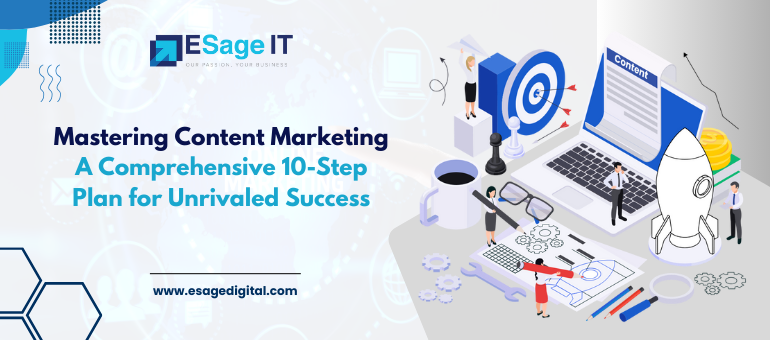- What We Do
-
-
Search Engine Optimization
-
PPC Management
Digital Brand Building
-
Social Media Management
-
E-commerce Digital Marketing
White label
-
-
-
- The Digital Edge
- Info-sphere
- Get Proposal
- Free SEO Audit

In the dynamic landscape of contemporary marketing, content reigns supreme. It’s not just about crafting web pages, blogs, or social media snippets; it’s about orchestrating a strategic, multi-faceted symphony that resonates with your audience at every juncture of their journey. In this definitive guide, we unravel the complexities of content marketing, providing an in-depth 10-step plan to elevate your strategy, ensuring not only visibility but dominance in your niche.
1. Set Objectives: Navigating the Marketing Funnel with Precision
The foundation of a potent content marketing strategy lies in setting well-defined objectives. These objectives must intricately align with every stage of the marketing funnel. By establishing Key Performance Indicators (KPIs) relevant to your business, you can systematically navigate each stage of the funnel, ensuring a measurable and focused approach to your objectives.
Example Objectives Breakdown:
Brand Reach and Engagement:
– Increase unprompted brand awareness.
– Expand reach and engagement on social media.
Consideration:
– Boost non-blog organic traffic.
– Grow blog traffic.
Conversion:
– Increase organic sales.
– Enhance data capture from the blog.
Advocacy:
– Amplify social media shares.
– Augment backlinks to the website.
– Elevate customer testimonials.
2. Understand Your Audience: Crafting Personas for Precision Targeting
Before embarking on content creation, delve deep into understanding your audience. Utilize tools such as Google Analytics (GA4) to dissect demographic information, interests, and browsing behaviors. Construct target buyer personas to tailor your content precisely to the unique needs of your audience, ensuring an empathetic connection.
Understanding Need States:
Emotive: Uncover desires or fears.
Social: Explore FOMO or vanity triggers.
Logical: Identify opportunities for financial gain.
3. Be Relevant: The Content Sweet Spot
Relevance is the fulcrum upon which successful content creation pivots. Unlike brands that fixate on what they wish to communicate, astute content marketing centers around delivering precisely what the customer seeks. Achieving relevance involves a multi-pronged approach, including keyword research, social listening, SEO leverage, in-house data review, continuous experimentation, A/B testing, and direct customer inquiries.
Also, read: A Guide to Mastering Threads: Your Ultimate Marketing Companion
4. Use the Content Marketing Funnel: A Strategic Sales Guide
Understanding and implementing the McKinsey model of the customer journey is pivotal. Tailoring your content strategy to each stage ensures a seamless transition from brand awareness to conversion and advocacy.
Strategic Approach:
Consideration Stage: Boost brand reach through engaging content and optimized SEO.
Evaluation Stage: Foster brand advocacy through customer testimonials and influencer engagement.
Purchase Stage: Leverage brand recognition for sales.
Post-Purchase Stage: Enhance upsell and renewals through targeted content.
5. Establish Your Content Pillars: Building a Solid Thematic Foundation
Content pillars serve as the thematic backbone of your strategy, blending brand-focused thought leadership with commercial drivers. Choose two to four key business pillars, ensuring a harmonious balance. Every piece of content should seamlessly fall under these pillars to maintain thematic consistency across your content ecosystem.
Content Pillars Example:
Brand Pillars: Thought leadership, brand values, innovation.
Commercial Pillars: Product launches, industry insights, client success stories.
6. Develop a Push-and-Pull Approach: Achieving Communication Equilibrium
Craft a nuanced strategy that seamlessly integrates both push and pull tactics. Striking the right balance ensures active communication without overwhelming or underwhelming your audience.
Effective Push Strategies:
Social Media Promotion: Actively promote products or services.
Podcasts/Webinars: Showcase brand offerings to capture data.
Strategic Pull Tactics:
SEO Optimization: Attract users to your website organically.
Referral Programs: Encourage customers to refer others.
Also, read: How to Master Competitive Analysis in Digital Marketing and Dominate Your Niche
7. Use a Hub-and-Spoke Model: Focused and Strategic Content Generation
The hub-and-spoke model centers around creating content focused on broad topics. This not only establishes authority in a niche but also enhances keyword rankings, traffic, and critical metrics like conversions, leads, and sales.
8. Create Data-Capture Content: Strategic Value Exchange
Prompt users to provide personal information with enticing data-capture content strategically placed on high-traffic pages. Offer valuable content such as ebooks, infographics, webinars, or guides, ensuring a fair and perceived value exchange.
Data-Capture Content Types:
Ebooks
Infographics
Original Research
Expert-led Webinars
Live Videos
In-depth Guides
Templates
Toolkit
Tests
9. Amplify Your Brand Using Advocates: Leveraging Trust for Organic Growth
In an era where trust in advertising is waning, advocates emerge as powerful conduits for brand amplification. Identify influencers, loyal customers, and referrals as potent advocates for your brand. This includes micro-influencers, satisfied customers, and referral-based leads, significantly amplifying your brand voice.
Advocate Types:
Influencers: Micro-influencers, SMEs for authenticity.
Loyal Customers: Utilize reviews and testimonials.
Referrals: Tap into the trust associated with recommendations.
Also, read: How to Maximize the Impact of Hashtags on Social Media?
10. Set KPIs and Measure Success: Proving ROI with Analytical Precision
Setting Key Performance Indicators (KPIs) is not just a checkbox; it’s a lifeline for your content marketing strategy. Regularly assess metrics such as website traffic, new vs. returning visitors, dwell time, engagement, downloads or sign-ups, bounce rate, conversions, backlinks, and shares. Employ a comprehensive Content Marketing dashboard for ongoing evaluation and continual improvement.
Embark on your journey to content marketing mastery, armed with these ten steps. Success lies not just in the creation of content but in its strategic orchestration, ensuring resonance with your audience at every touchpoint.